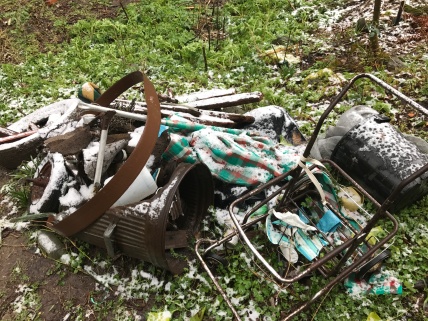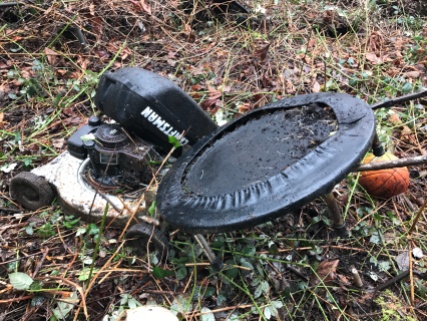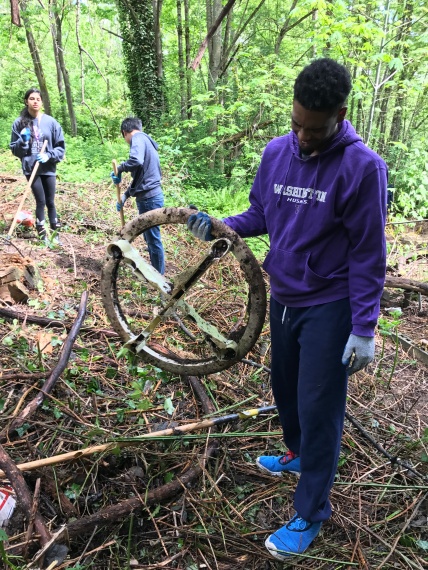
Nature on its own is indeed beautiful and clean. The hills and rivers do not need us to clean them. In fact, it is nature’s water which cleans us; it is trees which purify air for us. Because we have littered, we have spoilt its pristine beauty.
~Amma
I once read that every piece of plastic that ever existed still exists. While that statement has been challenged (politifact.com), there is no disputing the fact that plastics decompose very slowly and some may never decompose.
We have certainly seen evidence of the long life of plastic in the GreenFriends Greenbelt Restoration Project that Seattle Satsang members are leading. The areas we are restoring have been covered by blackberry, ivy and bindweed vines for 30-60 years. With the aid of Green Seattle Partnership, the City of Seattle Parks Department, and volunteer groups such as students from the University of Washington’s Introduction to Environmental Science course, we are helping to return this stretch of Greenbelt to the beautiful forest it once was.
When the Seattle Parks Department staff initially cut down the blackberry vines for us, they discovered the foundation of a house that had burned down in the 1950’s. We found many plastic items in or near that foundation. It appears that a lot of plastic trash was also thrown into the Greenbelt by nearby residents and passersby.
My house borders this Greenbelt property. When I cleaned out my bird houses last winter, I found a sizable bird nest. I was shocked by the amount of plastic a bird had used in constructing it (Photo 1). Photo 2 shows the pile of plastic I removed when I took the nest apart.
My experience with the bird nest opened my eyes to all the plastic that was in our Greenbelt site. After than, anytime I walked through the property, I saw that the ground was littered with flecks of plastic. I worried about the toxicity of the plastic and also remembered a photo that I once had seen of the contents of the stomach of dead albatross at Midway Island. (See Photo 3.) I felt an urgency for us to remove as much plastic from the site as possible, before the birds could start using it for nesting material.

We invited Seattle Satsang’s Bala Kendra group (our spiritual community’s children’s group) to come pick up litter. Photos 4 and 5 show the litter they picked up in one hour’s time. In addition to this diverse pile of garbage, they removed many small flecks of plastic from the ground.
Much of the trash our volunteers have removed from the site during the past year has been plastic. While the items might be dirty, as you can see in Photos 6-13, many of them look basically the same as they did decades ago.
Yesterday, I picked up the remains of a pile of burlap bags that we use to cover the ground after we clear it. Under the pile I saw this:

I went back later and pulled out some of that trash so that I could photograph it. Photo 15 shows those items. There was rope, candy wrappers, a garden stake, line string for a trimmer/edger, a plant sign, carpet pad and assorted other kinds of plastic.

Today I remembered another piece of plastic I had recently seen. I went back to that place and began to pull the plastic bag out of the ground. Photo 16 and Photo 17 show what I uncovered. Often, when I pull out plastic, what emerges is even bigger than this!
I wonder if we will ever come to the end of the plastic trash on this site! Maybe not, but every piece someone removes helps reduce the negative impact that humans have had on nature in this space and gives nature a chance to restore itself to its pristine beauty.















Very impactful post!
Just what exactly should I DO with the bits of this nemesis to Nature that I also find???
LikeLiked by 1 person
Most of it will go to trash and end up in the landfill. Some things might be able to be reused by you or others. I use a cup and some glasses I found there and I usetwo dinosaurs that were in good shape as decorations in the midst of ferns.
LikeLiked by 1 person
And I kept a pair of handcuffs and a plumbers kit that were probably from the 50’s as examples of treenbelt trash. They were both made of metal.
LikeLiked by 1 person
Wow, bizarre and amazing!
LikeLiked by 1 person
I don’t know that I have kept any plastic. I washed the doll and stuffed animals that were in one of the photos but decided I couldn’t guarantee that they didn’t carry disease or critters so didn’t give them to kids.
LikeLiked by 1 person
I think you are recruiting a plastics pick-up army, wow, wouldn’t that be great!
LikeLiked by 1 person
That would be awesome! I hope you are right.
LikeLike
Very inspiring! This reminds me that every piece of plastic I use (or choose not to) matters – and could harm another creature’s life… humbling and a good wake up call. Thank you.
PS I like the use of the dinosaurs as garden art 🙂
LikeLiked by 1 person
I love seeing those dinosaurs every time I walk up from the Greenbelt. Ferns were already present when dinosaurs roamed the earth.
LikeLike
And I loved what you said about plastic choices.
LikeLike